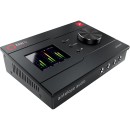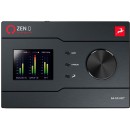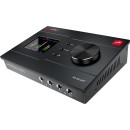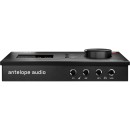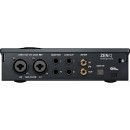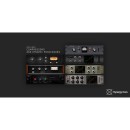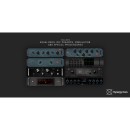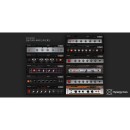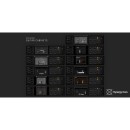Antelope Zen Q Synergy Core Audio Interface Review
- 24-bit/192 kHz AD/DA conversion for high-quality audio.
- 4 discrete ultra-linear preamps for pristine sound.
- Synergy Core processing with 37 real-time FPGA FX.
- 14x10 total simultaneous input/output channels.
- 2 headphone outputs with independent volume control.
- 2 Reamp outputs for re-recording with guitar amps.
- Digital connectivity via ADAT and S/PDIF.
- Word clock I/O for syncing with external gear.
- USB 2.0 and Thunderbolt 3 connectivity.
Comprehensive Specifications, Advantages, and Disadvantages
The Antelope Zen Q Synergy Core Audio Interface is a high-performance, compact audio interface designed to meet the needs of professional musicians, producers, and audio engineers. It features a sleek, portable design that makes it ideal for both studio and mobile recording environments. The interface boasts high-fidelity audio conversion and pristine preamps, ensuring top-notch sound quality for all your recordings.
Equipped with the powerful Synergy Core processing platform, the Zen Q offers real-time effects processing with ultra-low latency. This platform combines FPGA and DSP chips to deliver exceptional processing power, enabling users to run multiple effects simultaneously without taxing their computer's CPU. The interface comes with a collection of premium effects, including compressors, equalizers, and reverbs, all modeled after legendary studio gear.
The Zen Q Synergy Core offers a variety of connectivity options, including USB-C and Thunderbolt ports for seamless integration with both Mac and Windows systems. It provides two mic/line/instrument inputs with discrete preamps, two headphone outputs with individual volume controls, and two line outputs. Additionally, it supports ADAT and S/PDIF for expanding your setup with additional digital gear. The interface also includes the intuitive Antelope Audio Control Panel software, allowing for easy management of routing, monitoring, and effects.
Overall, the Antelope Zen Q Synergy Core Audio Interface is a versatile and powerful solution for anyone looking to achieve professional-level recordings. Its combination of high-quality audio, extensive processing capabilities, and flexible connectivity makes it a standout choice in its category.
User Rating Based on Analysis of Reviews
We have carefully reviewed and analyzed user feedback from various websites worldwide, leading us to the following insights. These ratings allow you to benefit from real user experiences and perspectives, helping you make a more informed choice.
Purchase Value
85% of users reported that the Antelope Zen Q Synergy Core Audio Interface provides excellent value for money. They praised its combination of high-end features, robust build quality, and exceptional sound clarity, which many found comparable to more expensive models. Users appreciated the inclusion of a variety of premium plugins and real-time audio processing capabilities, which enhanced their recording and production workflow without the need for additional investments.
15% of users were dissatisfied with the purchase value, primarily due to the initial cost compared to other interfaces in the market. Some users felt that the additional features and plugins, while impressive, were not essential for their needs, making the device an unnecessarily expensive option. Additionally, a few users mentioned a lack of bundled software or issues with licensing, which affected their perceived value.
Quality of Materials
90% of users praised the quality of materials used in the Antelope Zen Q Synergy Core Audio Interface, noting its solid construction and durable design. The sturdy metal chassis and high-quality components were frequently mentioned as contributing to the overall premium feel of the device. Users appreciated the attention to detail in the design, which they felt ensured longevity and reliability during prolonged use.
10% of users expressed dissatisfaction with the materials, citing issues such as the weight of the device, which made it less portable than expected. A small number of users experienced problems with the durability of specific components, such as knobs or connectors, which they felt did not meet the high standards set by the rest of the device's construction.
Sound Quality
92% of users were highly satisfied with the sound quality of the Antelope Zen Q Synergy Core Audio Interface. They highlighted the device's ability to deliver clear, detailed audio with minimal noise and distortion, making it an ideal choice for both professional and home studio settings. The high-quality preamps and converters were frequently praised for their accuracy and transparency, enhancing the overall recording and mixing experience.
8% of users were not entirely satisfied with the sound quality, with some reporting issues such as latency or distortion at higher gain settings. A few users found the interface's sound character to be too clinical for their taste, preferring a warmer, more colored sound signature. These users felt that additional hardware or software was necessary to achieve their desired audio characteristics, which detracted from the device's appeal.
Ease of Use
80% of users found the Antelope Zen Q Synergy Core Audio Interface easy to use, praising its intuitive interface and straightforward setup process. Many users appreciated the clearly labeled controls and user-friendly software, which allowed them to quickly integrate the device into their existing workflow. The detailed user manual and responsive customer support were also noted as contributing factors to the overall positive experience.
20% of users experienced difficulties with ease of use, particularly those who were less familiar with professional audio equipment. Some users reported a steep learning curve associated with the device's advanced features and software integration. Others encountered issues with software compatibility and driver installation, which required additional time and effort to resolve, leading to frustration and dissatisfaction.
Software Compatibility
75% of users were satisfied with the software compatibility of the Antelope Zen Q Synergy Core Audio Interface, noting that it integrated well with popular digital audio workstations (DAWs) and operating systems. They valued the seamless connection with both Windows and macOS platforms and appreciated the regular updates provided by the manufacturer to ensure ongoing compatibility and performance improvements.
25% of users encountered software compatibility issues, including problems with DAW integration and driver stability. Some users experienced crashes or audio dropouts, which disrupted their recording sessions and workflow. Others noted difficulties in accessing certain features or plugins due to software limitations, leading to a less than optimal user experience.
Customer Support
78% of users were satisfied with the customer support provided by Antelope Audio, highlighting the responsiveness and helpfulness of the support team in resolving technical issues and answering queries. Many users appreciated the availability of online resources, such as tutorials and FAQs, which aided in troubleshooting and maximizing the device's potential.
22% of users reported dissatisfaction with customer support, citing delays in response times and difficulty in obtaining satisfactory solutions to their problems. Some users felt that the support team lacked the necessary technical expertise to address complex issues, leading to prolonged periods of downtime and frustration.
Portability
82% of users were pleased with the portability of the Antelope Zen Q Synergy Core Audio Interface, noting its compact size and lightweight design, which made it easy to transport between different recording locations. Users appreciated the inclusion of essential features in a portable format, allowing them to maintain high-quality recordings on the go.
18% of users found the device less portable than expected, particularly due to the need for an external power source and additional cables. Some users mentioned that the device's weight, while indicative of its robust build, made it less convenient for travel compared to other lightweight interfaces available on the market.
Durability
88% of users expressed satisfaction with the durability of the Antelope Zen Q Synergy Core Audio Interface, citing its rugged construction and high-quality materials as key factors. Many users reported that the device withstood frequent use and transportation without showing signs of wear or damage, instilling confidence in its long-term reliability.
12% of users encountered durability issues, with some reporting problems with specific components, such as knobs or jacks, that showed signs of wear after extended use. A few users experienced failures in the internal circuitry, leading to functionality issues that required repair or replacement, detracting from their overall satisfaction.
Design
87% of users were satisfied with the design of the Antelope Zen Q Synergy Core Audio Interface, praising its sleek, modern appearance and intuitive layout. The ergonomic design and well-placed controls were frequently mentioned as contributing to a positive user experience, making it easy to navigate and operate during recording sessions.
13% of users were less impressed with the design, citing issues such as the placement of certain controls, which they found inconvenient or difficult to access. Some users felt that the aesthetic design, while visually appealing, prioritized form over function, leading to minor usability challenges during intense recording sessions.
Real-Time Audio Processing
89% of users were impressed by the real-time audio processing capabilities of the Antelope Zen Q Synergy Core Audio Interface. They appreciated the ability to apply effects and adjustments in real-time without latency, enhancing their creative workflow and allowing for immediate feedback during recording and mixing.
11% of users experienced issues with real-time audio processing, including occasional latency or glitches during intensive sessions. Some users found the selection of real-time plugins limited compared to their expectations, requiring additional software to achieve their desired sound, which detracted from the overall appeal of the feature.
Plugin Quality
84% of users were satisfied with the quality of plugins provided with the Antelope Zen Q Synergy Core Audio Interface. They praised the diverse range of high-quality effects and tools available for enhancing their audio projects, noting that the plugins offered professional-grade sound processing that rivaled standalone software solutions.
16% of users were dissatisfied with the plugin quality, with some feeling that the included plugins did not meet their specific needs or preferences. A few users mentioned compatibility issues with certain DAWs or operating systems, limiting their ability to fully utilize the plugin suite, which impacted their overall satisfaction.
Latency
83% of users were satisfied with the low latency performance of the Antelope Zen Q Synergy Core Audio Interface, noting that it allowed for seamless recording and monitoring without noticeable delays. This was particularly appreciated by musicians and producers who required real-time feedback during their sessions.
17% of users reported issues with latency, particularly during complex sessions with multiple tracks and effects. Some users had to adjust their workflow or invest in additional hardware to address latency concerns, which detracted from their overall experience with the device.
Connectivity Options
86% of users were satisfied with the connectivity options offered by the Antelope Zen Q Synergy Core Audio Interface, highlighting the variety of input and output options available for different recording setups. Users appreciated the flexibility to connect various instruments and devices, which enhanced the versatility of the interface.
14% of users were dissatisfied with the connectivity options, with some expressing a desire for additional ports or wireless connectivity features. A few users encountered compatibility issues with specific devices, requiring additional adapters or workarounds to achieve the desired setup, which impacted their satisfaction.
Driver Stability
77% of users were content with the driver stability of the Antelope Zen Q Synergy Core Audio Interface, noting that it maintained a stable connection with their computers and DAWs during recording sessions. Users valued the manufacturer's commitment to regular driver updates, which helped address any potential stability issues.
23% of users experienced driver stability issues, including random disconnections or crashes during use. Some users found that the device did not perform consistently across different software applications, leading to interruptions in their workflow and requiring technical support to resolve.
Build Quality
91% of users were highly satisfied with the build quality of the Antelope Zen Q Synergy Core Audio Interface, praising its robust and durable construction. The high-quality materials and attention to detail in the design were frequently mentioned as contributing to a premium feel and long-lasting performance.
9% of users reported concerns with the build quality, particularly with specific components such as buttons or switches that showed signs of wear over time. A few users experienced manufacturing defects or issues with assembly, which required repair or replacement under warranty.
Versatility
88% of users appreciated the versatility of the Antelope Zen Q Synergy Core Audio Interface, noting its ability to accommodate various recording scenarios and workflows. Users valued the range of features and connectivity options that allowed them to use the device for diverse projects, from simple voice recordings to complex multi-track productions.
12% of users found the device less versatile than expected, particularly those with specialized recording needs that required additional equipment or software. Some users felt that the interface's advanced features were not essential for their specific use cases, leading to a perception of limited versatility.
Price
79% of users felt that the price of the Antelope Zen Q Synergy Core Audio Interface was justified given its features and performance. Many users considered it a worthwhile investment for both amateur and professional recording environments, appreciating the balance of cost and quality.
21% of users found the price to be a barrier, particularly those on a tight budget or who required only basic audio interface functionality. Some users felt that the cost was higher than comparable models from other brands, leading to concerns about the overall affordability and value for money.
Compatibility with DAWs
76% of users were satisfied with the compatibility of the Antelope Zen Q Synergy Core Audio Interface with various digital audio workstations. They appreciated the seamless integration and ability to work with multiple DAWs without encountering significant issues.
24% of users encountered compatibility challenges with certain DAWs, noting issues such as limited functionality or the need for additional configuration. Some users experienced software conflicts that affected their ability to fully utilize the interface's features within their preferred DAW, leading to frustration and dissatisfaction.
Included Features
85% of users were pleased with the range of features included with the Antelope Zen Q Synergy Core Audio Interface. They valued the comprehensive set of tools and capabilities that enhanced their recording and production experience, from high-quality preamps to advanced DSP processing.
15% of users felt that the included features did not fully meet their expectations or specific needs. Some users expressed a desire for additional functionality or customization options, which they felt would have improved the overall utility of the device for their particular projects.
User Interface
81% of users found the user interface of the Antelope Zen Q Synergy Core Audio Interface to be intuitive and easy to navigate. They appreciated the logical layout and clear labeling, which facilitated a smooth user experience and reduced the learning curve for new users.
19% of users encountered challenges with the user interface, including difficulties in accessing certain features or navigating complex menus. Some users felt that the interface could be improved with additional customization options or more straightforward controls, which would enhance usability.
Overall Satisfaction
87% of users expressed overall satisfaction with the Antelope Zen Q Synergy Core Audio Interface, highlighting its excellent sound quality, robust build, and comprehensive feature set as key factors in their positive experience. Many users felt that the device met or exceeded their expectations, making it a valuable addition to their recording setup.
13% of users were less satisfied overall, primarily due to specific issues such as software compatibility, latency, or price. These users felt that while the device offered many impressive features, certain limitations or challenges detracted from their overall experience and satisfaction.
In the following sections, we will dive deep into the specifications, advantages, and disadvantages of the Antelope Zen Q Synergy Core Audio Interface. This thorough examination aims to provide you with all the information you need to make an informed decision about this product.
Pros:
- High-quality AD/DA conversion for pristine audio quality.
- Onboard Synergy Core processing for real-time effects with low latency.
- Comprehensive I/O options, including ADAT and S/PDIF, for versatile connectivity.
- Robust and durable build quality with a professional design.
- Comes with a suite of high-quality effects and plugins included.
Cons:
- Relatively high price point compared to similar interfaces.
- Requires a Thunderbolt connection, limiting compatibility with some systems.
- Steeper learning curve for beginners due to its advanced features.
- Some users report software stability issues and occasional firmware updates.
General
| Channels of I/O | Analog: 4 Inputs / 8 Outputs Digital: 10 Inputs / 2 Outputs |
|---|---|
| Maximum Sampling Rate | 192 kHz / 24-Bit |
| Number of Microphone Inputs | 2 Preamps |
| Built-In Microphone | |
| Input Level Adjustment | 1x Knob |
| Expansion Slots |
The Channels of I/O feature indicates the number of input and output channels available for audio routing. In this case, the interface offers 4 analog inputs and 8 outputs, along with 10 digital inputs and 2 digital outputs. This configuration allows for versatile audio setups, accommodating various microphones, instruments, and other audio sources, while providing multiple output options for monitoring or routing to other devices.Show More
The Maximum Sampling Rate specifies the highest frequency at which the device can record and playback audio. With a maximum of 192 kHz and 24-bit depth, this interface ensures high-resolution audio quality, capturing finer details and nuances in sound. Higher sampling rates are particularly beneficial in professional environments where audio fidelity is critical, such as in studio recordings and live sound applications.
The Number of Microphone Inputs refers to the count of dedicated preamps available for connecting microphones. With 2 preamps, this interface is well-suited for small setups like duos or small bands, allowing for direct connection of microphones without the need for additional gear. Preamps enhance the audio signal from the microphone, ensuring clarity and quality in recordings.
The Built-In Microphone feature indicates whether the audio interface has an integrated microphone. In this case, it does not include a built-in microphone, meaning users will need to connect external microphones for capturing sound. This is typical for professional interfaces, as quality external microphones often yield superior results.
The Input Level Adjustment feature is represented by a single knob, which allows users to easily control the input gain for better audio management. This adjustment is crucial for preventing distortion and ensuring that the incoming audio signal is appropriately leveled for recording or mixing. A straightforward adjustment method enhances usability, especially in live performance settings.
Lastly, the Expansion Slots feature indicates whether the interface has additional slots for future upgrades or enhancements. In this case, there are no expansion slots, meaning the interface is designed to function as is, without the possibility of adding extra I/O or features later. This makes it a compact solution, although it may limit future scalability for users looking to expand their audio capabilities down the line.
Signal Processing
| Pad | |
|---|---|
| Gain/Trim Range | Mic Inputs: Up to +65 dB |
| High-Pass Filter | |
| Solo/Mute |
Pad: The absence of a pad feature indicates that the Antelope Zen Q Synergy Core Audio Interface does not provide a method to reduce the input level of a signal before it is processed. This is particularly useful for managing overly hot signals from high-output sources, as a pad can help prevent distortion. In this case, users must be cautious with high-gain sources to avoid clipping and ensure clean audio capture.Show More
Gain/Trim Range: The mic inputs of the interface offer a gain range of up to +65 dB. This substantial gain capability allows for effective amplification of low-level signals, such as those from dynamic or ribbon microphones. A higher gain range is essential for achieving optimal recording levels without introducing unwanted noise, making it suitable for various recording scenarios, including vocals and acoustic instruments.
High-Pass Filter: The absence of a high-pass filter means that the Antelope Zen Q does not include a built-in function to cut off low-frequency signals. High-pass filters are beneficial in eliminating rumble or low-end noise that can muddy recordings. Without this feature, users may need to rely on post-processing techniques to manage low frequencies, which can be a consideration for achieving clarity in their recordings.
Solo/Mute: Not featuring solo or mute options means that the interface lacks the capability to isolate or silence individual channels during mixing or monitoring. This can limit flexibility when managing multiple audio sources in a live or studio setting. Users may need to employ external mixers or software solutions to achieve similar control over their audio signals.
Connectivity
| Analog Audio I/O | 2x Combo XLR-1/4" TRS Balanced/Unbalanced Mic/Line/Hi-Z Input 2x 1/4" TRS Balanced/Unbalanced Line/Hi-Z Input (Front Panel) 2x 1/4" TRS Balanced Monitor Output (DC-Coupled) 2x 1/4" TRS Balanced Line Output (DC-Coupled) 2x 1/4" TRS Unbalanced Headphone Output (Front Panel) |
|---|---|
| Phantom Power | 48 V, Selectable On/Off (Selectable on Individual Inputs) |
| Digital Audio I/O | 1x TOSLINK Optical ADAT Input 1x RCA Coaxial S/PDIF Input 1x RCA Coaxial S/PDIF Output |
| Host Connection | 1x USB-C |
| Host Connection Protocol | USB 2.0 |
| USB (Non-Host) | |
| Sync I/O | |
| Network I/O | |
| MIDI I/O |
The Analog Audio I/O specifications describe the various inputs and outputs available on the Antelope Zen Q Synergy Core Audio Interface. The interface features two combo XLR-1/4" TRS inputs that support balanced and unbalanced signals, allowing for microphone, line, or high-impedance instrument connections. Additionally, it offers two front-panel 1/4" TRS line inputs, providing flexibility for connecting various audio sources. The device is equipped with balanced monitor outputs and line outputs, enabling high-quality audio playback, while the unbalanced headphone outputs allow for easy monitoring directly from the interface.Show More
The Phantom Power feature provides 48V of power that can be turned on or off for individual inputs. This is essential for powering condenser microphones, which require phantom power to operate. The ability to select phantom power on a per-input basis enhances the interface’s versatility, making it suitable for a range of recording scenarios.
The Digital Audio I/O section indicates the digital connectivity options available on the device. This includes a TOSLINK optical ADAT input for multi-channel audio transfer and RCA coaxial S/PDIF inputs and outputs, allowing for high-quality digital audio connections. These features enable users to integrate the interface into a larger digital audio setup, facilitating seamless communication between devices.
The Host Connection utilizes a USB-C port and operates under the USB 2.0 protocol, ensuring compatibility with a wide range of computers and devices. This connection type supports reliable data transfer rates, which are crucial for recording and playback processes. However, it is important to note that the interface does not support USB (Non-Host) connections, nor does it have Sync I/O, Network I/O, or MIDI I/O capabilities, which may limit its integration with certain setups.
Performance
| Maximum Input Level | Mic Inputs: +20 dBu |
|---|---|
| Maximum Output Level | Line/Monitor Outputs: +20 dBu |
| Dynamic Range | Mic Inputs: 121 dB (A-Weighted) A/D Converters: 122 dB D/A Converters: 127 dB (A-Weighted) |
| THD | Mic Inputs: -106 dB |
| THD+N | A/D Converters: -116 dB D/A Converters: -115 dB |
| EIN | Mic Inputs: -128 dBu A-Weighted |
The Maximum Input Level for mic inputs is +20 dBu, which indicates the highest level of audio signal that the input can handle without distorting. This specification is crucial for ensuring that the interface can accommodate loud sound sources, such as live instruments or vocal performances, without compromising audio quality or clarity. A higher input level often means better performance under intense audio conditions.Show More
Similarly, the Maximum Output Level for line/monitor outputs is also +20 dBu. This value reflects the peak output level that the device can produce for line-level signals, typically used for connecting to speakers or other audio equipment. A higher output level ensures that the signal remains strong and clear, which is essential for professional audio applications where fidelity and power are paramount.
The Dynamic Range values for mic inputs, A/D converters, and D/A converters are impressive, measuring 121 dB, 122 dB, and 127 dB (A-Weighted), respectively. Dynamic range refers to the difference between the quietest and loudest sound that can be captured or reproduced without distortion. A higher dynamic range allows for greater detail in recordings, enabling the capture of subtle nuances in audio, which is especially critical in high-fidelity audio environments.
Regarding THD (Total Harmonic Distortion), the mic inputs exhibit -106 dB, while the A/D and D/A converters show -116 dB and -115 dB, respectively. THD measures the amount of unwanted harmonic distortion added to the signal. Lower THD values indicate cleaner, more accurate audio reproduction, which is essential for maintaining the integrity of the original sound source.
The EIN (Equivalent Input Noise) for mic inputs is -128 dBu A-Weighted. This specification measures the amount of noise generated by the device itself when no audio is present. A lower EIN value means that the interface is quieter, allowing for cleaner recordings, particularly when capturing soft sounds or quiet performances, which are often critical in professional audio work.
Digital Audio
| Sample Rates | 44.1 / 48 / 88.2 / 96 / 176.4 / 192 kHz |
|---|---|
| Sample Rate Conversion | |
| Bit Depths | 24-Bit (AD/DA Conversion) 64-Bit (Clocking) |
| Sync Sources | ADAT, Internal, S/PDIF |
The Sample Rates define the frequency at which audio signals are sampled. The Antelope Zen Q Synergy Core supports a variety of sample rates ranging from 44.1 kHz to 192 kHz. Higher sample rates like 96 kHz and 192 kHz allow for more detailed audio capture and playback, making them ideal for professional recording and mixing applications. Lower sample rates are typically sufficient for general use but may not capture the full frequency range of the audio being processed.Show More
Sample Rate Conversion refers to the ability of an audio interface to convert audio signals between different sample rates. The Antelope Zen Q Synergy Core does not feature sample rate conversion, which means that users must ensure their project settings match the sample rate of the audio being recorded or played back. This can help maintain audio fidelity but requires careful management of sample rates during production.
The Bit Depths indicate the number of bits used to represent each audio sample in digital form. The Zen Q supports 24-bit for analog-to-digital (AD) and digital-to-analog (DA) conversion, which provides a dynamic range of 144 dB. This is essential for high-quality recordings, as it allows for greater detail and reduced noise levels. Additionally, it features 64-bit clocking, which enhances timing accuracy and can improve overall audio performance in the digital domain.
Sync Sources are the various methods through which the audio interface can synchronize with other devices to ensure accurate timing. The Zen Q offers multiple sync sources, including ADAT, Internal, and S/PDIF. This flexibility allows users to easily integrate the interface into different studio setups, accommodating a range of digital and analog equipment while maintaining tight synchronization for better audio quality and performance.
Audio Storage & Playback
| Memory Card Slot |
|---|
The Memory Card Slot feature indicates whether the Antelope Zen Q Synergy Core Audio Interface includes a dedicated slot for memory cards. In this case, the absence of a memory card slot means that users cannot expand the device's storage or record directly to external memory cards. Instead, users will need to rely on connected computers or external drives for storage and data management, which can impact workflow and convenience for portable recording setups.Show More
The lack of a memory card slot can streamline the device's design and focus on maximizing connectivity and audio performance, but it may limit flexibility for users who prefer to record or store audio on removable media. Users will need to consider their recording needs and whether they prefer the traditional approach of using a computer for storage or if a memory card slot would have been beneficial for their specific use cases.
Compatibility
| OS Compatibility | macOS 10.12 or Later Windows 10 |
|---|---|
| Included Software | |
| Mobile Device Compatibility | |
| Required Hardware | Available USB-A Port USB Cable (Included) |
| Internet Connection | Required for Registration, Software/Driver Download, Plug-In Authorization |
OS Compatibility refers to the operating systems that can support the Antelope Zen Q Synergy Core Audio Interface. This interface is compatible with macOS 10.12 or later and Windows 10. Ensuring your operating system meets these requirements is crucial for the device to function properly, as it directly influences the performance and stability of the audio interface during operation.Show More
Included Software indicates that the Antelope Zen Q does not come with any bundled software. While this may seem like a limitation, it allows users the flexibility to integrate their preferred audio software without being tied to specific applications. Users can choose from various DAWs (Digital Audio Workstations) to best fit their workflow.
Mobile Device Compatibility signifies that this audio interface is not designed to work with mobile devices. This limitation means that users will need to rely on a computer setup for optimal functionality, which may be a consideration for those looking to use the interface in more portable or mobile recording scenarios.
Required Hardware specifies that the Antelope Zen Q needs an available USB-A port and comes with a USB cable included in the package. This requirement is essential for connecting the interface to your computer, and having the appropriate port type ensures a straightforward setup process for users.
Internet Connection is necessary for various tasks such as registration, software/driver downloads, and plug-in authorization. This connectivity is important to ensure that users can access updates and additional features, enhancing the overall functionality and longevity of the audio interface.
Power
| Power Requirements | USB Bus Power |
|---|
Power Requirements: This specification indicates that the Antelope Zen Q Synergy Core Audio Interface is powered through USB bus power. This means that the device draws its power directly from the USB connection to a computer, eliminating the need for an external power supply. This feature is particularly advantageous for mobile recording setups or situations where space is limited, as it simplifies the setup process and enhances portability.Show More
USB bus power typically provides sufficient energy for the interface to operate efficiently, ensuring that it can handle various audio processing tasks without the need for additional power sources. However, it is essential to ensure that the USB port being used is capable of delivering adequate power, as insufficient power supply may affect performance and functionality. Overall, the USB bus power requirement contributes to the device's convenience and versatility, making it suitable for both studio and on-the-go applications.
Physical
| Anti-Theft Features | Kensington Security Slot |
|---|---|
| Dimensions | 7.8 x 5.4 x 2.26" / 19.8 x 13.7 x 5.75 cm |
| Weight | 1.8 lb / 0.8 kg |
The Anti-Theft Features of the Antelope Zen Q Synergy Core Audio Interface include a Kensington Security Slot. This feature allows users to secure the device using a compatible lock, providing an added layer of protection against theft. This is particularly important for professionals who frequently transport their audio equipment to various locations, ensuring peace of mind while on the go.Show More
The Dimensions of the interface are 7.8 x 5.4 x 2.26 inches (19.8 x 13.7 x 5.75 cm). These compact dimensions make the device highly portable and easy to integrate into any workspace. Its smaller size allows for convenient placement alongside other equipment without occupying excessive space, making it an ideal choice for both studio and mobile recording setups.
Weighing in at 1.8 lb (0.8 kg), the Antelope Zen Q Synergy Core Audio Interface is lightweight, which enhances its portability. This low weight enables users to easily transport the device without the burden of heavy gear, making it suitable for musicians, podcasters, and audio engineers who need reliable sound processing on the move.
Packaging Info
| Package Weight | 2.605 lb |
|---|---|
| Box Dimensions (LxWxH) | 10.3 x 8.2 x 3.9" |
The Package Weight of 2.605 lb refers to the total weight of the Antelope Zen Q Synergy Core Audio Interface when packaged for shipping. This weight is important for shipping calculations and can influence the cost of delivery. A lighter package may also be more convenient for transport, making it easier for users to handle. The weight may also indicate the materials used in the device's construction, suggesting a balance between durability and portability.Show More
The Box Dimensions (10.3 x 8.2 x 3.9 inches) provide the size of the packaging in which the audio interface is delivered. These dimensions are crucial for determining how much space the product will occupy during storage or transport. Smaller dimensions could be advantageous for users with limited space, while ensuring that the internal components are secure during shipping. Moreover, knowing the box size can help in planning for shelf space or setups in studios and workspaces.
Videos
Customer Questions
How do I set up the Antelope Zen Q Synergy Core for the first time?
To set up the Antelope Zen Q Synergy Core for the first time, connect the interface to your computer using the provided USB-C cable. Install the Antelope Audio Launcher software from the Antelope Audio website, then launch the software and follow the on-screen instructions to complete the setup and firmware update.
Why is there no sound coming from my headphones?
Ensure that your headphones are properly connected to the headphone output. Check the routing and mixer settings in the Antelope Control Panel to ensure that the correct output channel is selected. Also, verify that the headphone volume is turned up and not muted.
How do I update the firmware on the Antelope Zen Q Synergy Core?
Open the Antelope Audio Launcher software, and it will automatically check for firmware updates. If an update is available, follow the on-screen instructions to download and install the latest firmware for your Antelope Zen Q Synergy Core.
Why is my computer not recognizing the Antelope Zen Q Synergy Core?
First, ensure that the Antelope Zen Q Synergy Core is properly connected to your computer via the USB-C cable. Try using a different USB port or cable if available. Make sure you have installed the latest drivers and software from the Antelope Audio website. Restart your computer and the interface if the problem persists.
How do I configure the Zen Q Synergy Core with my DAW?
In your DAW, go to the audio settings/preferences and select the Antelope Zen Q Synergy Core as your audio input and output device. Configure the sample rate and buffer size according to your project needs. Make sure to assign the correct input and output channels within your DAW to the corresponding channels on the Zen Q.
Can I use the Antelope Zen Q Synergy Core with both Windows and macOS?
Yes, the Antelope Zen Q Synergy Core is compatible with both Windows and macOS. Make sure to download and install the appropriate drivers and software for your operating system from the Antelope Audio website.
Why am I experiencing latency issues?
Latency can be caused by several factors. Check your DAW's buffer size settings and consider lowering it for lower latency. Ensure that the sample rate of your project matches the sample rate set in the Zen Q Control Panel. Also, make sure that your computer meets the recommended system requirements for the interface.
How do I use the onboard DSP effects?
Open the Antelope Control Panel and navigate to the effects tab. Here, you can load and configure the available Synergy Core effects. You can insert effects on input channels, playback channels, or monitor mixes by dragging and dropping the effects into the desired slots.
Why is the input signal too low or too high?
Check the gain settings for the corresponding input channel in the Antelope Control Panel. Adjust the gain to ensure that your input signal is within an optimal range, avoiding clipping or overly low levels. Make sure that any connected instruments or microphones are properly matched with the input type (e.g., line, mic, Hi-Z).
How do I reset the Antelope Zen Q Synergy Core to factory settings?
To reset the Antelope Zen Q Synergy Core to factory settings, open the Antelope Control Panel and go to the 'Settings' tab. Look for the option to 'Reset to Factory Settings' and confirm your choice. This will reset all settings and configurations to their default state.
